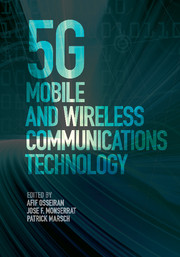Book contents
- Frontmatter
- Dedication
- Contents
- List of contributors
- Foreword
- Acknowledgments
- Acronyms
- 1 Introduction
- 2 5G use cases and system concept
- 3 The 5G architecture
- 4 Machine-type communications
- 5 Device-to-device (D2D) communications
- 6 Millimeter wave communications
- 7 The 5G radio-access technologies
- 8 Massive multiple-input multiple-output (MIMO) systems
- 9 Coordinated multi-point transmission in 5G
- 10 Relaying and wireless network coding
- 11 Interference management, mobility management, and dynamic reconfiguration
- 12 Spectrum
- 13 The 5G wireless propagation channel models
- 14 Simulation methodology
- Index
- References
5 - Device-to-device (D2D) communications
Published online by Cambridge University Press: 05 June 2016
- Frontmatter
- Dedication
- Contents
- List of contributors
- Foreword
- Acknowledgments
- Acronyms
- 1 Introduction
- 2 5G use cases and system concept
- 3 The 5G architecture
- 4 Machine-type communications
- 5 Device-to-device (D2D) communications
- 6 Millimeter wave communications
- 7 The 5G radio-access technologies
- 8 Massive multiple-input multiple-output (MIMO) systems
- 9 Coordinated multi-point transmission in 5G
- 10 Relaying and wireless network coding
- 11 Interference management, mobility management, and dynamic reconfiguration
- 12 Spectrum
- 13 The 5G wireless propagation channel models
- 14 Simulation methodology
- Index
- References
Summary
Direct Device-to-Device (D2D) communication, which refers to direct communication between devices (i.e. users) without data traffic going through any infrastructure node, has been widely foreseen to be an important cornerstone to improve system performance and support new services beyond 2020 in the future fifth generation (5G) system. In general, the benefits resulting from D2D operation include, among others, highly increased spectral efficiency, improved typical user data rate and capacity per area, extended coverage, reduced latency, and enhanced cost and power efficiency. These benefits are resulting from the proximity of the users employing D2D communication (proximity gain), an increased spatial reuse of time and frequency resources (reuse gain) and from using a single link in the D2D mode rather than using both an uplink and a downlink resource when communicating via the base station in the cellular mode (hop gain). The chapter starts with an overview of the fourth generation (4G) D2D development. Afterward, the challenges to be addressed in the context of 5G D2D and related key enablers are discussed. In particular, this chapter covers Radio Resource Management (RRM) for mobile broadband applications, multi-hop D2D communication, especially for public safety and emergency services, and multi-operator D2D communication.
D2D: from 4G to 5G
In the future 5G system, it is predicted that network-controlled direct D2D communication offers the opportunity for local management of short-distance communication links and allows separating local traffic from the global network (i.e. local traffic offloading). By doing this, it will not only remove the load burden on the backhaul and core network caused by data transfer and related signaling, but also reduce the necessary effort for managing traffic at central network nodes. Direct D2D communication therefore extends the idea of distributed network management by incorporating the end devices into the network management concept. In this way, the wireless user device with D2D capability can have a dual role: either acting as an infrastructure node and/or as an end-user device in a similar way as a traditional device. Further, direct D2D facilitates low-latency communication due to the local communication link between users in proximity. In fact, direct D2D has been seen as one of the necessary features to support real-time services in the future 5G system [1][2]. Another important aspect is reliability, where an additional D2D link can be employed to increase reliability through a larger extent of diversity.
- Type
- Chapter
- Information
- 5G Mobile and Wireless Communications Technology , pp. 107 - 136Publisher: Cambridge University PressPrint publication year: 2016
References
- 8
- Cited by



